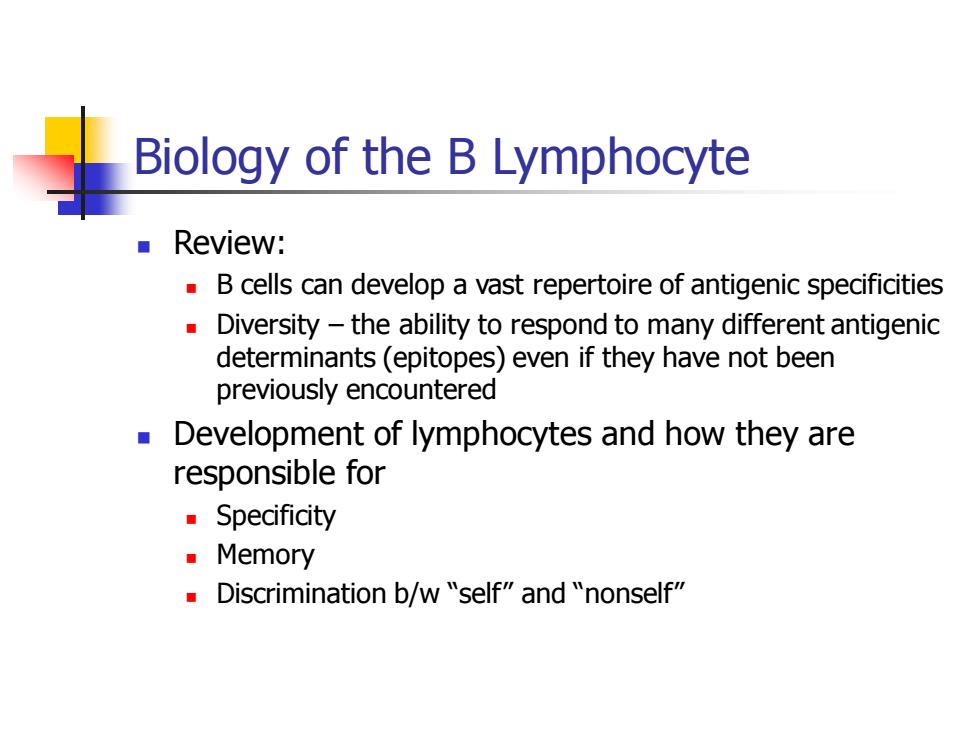
Biology of the B Lymphocyte Review: .B cells can develop a vast repertoire of antigenic specificities Diversity-the ability to respond to many different antigenic determinants(epitopes)even if they have not been previously encountered Development of lymphocytes and how they are responsible for ·Specificity Memory Discrimination b/w "self"and "nonself
Biology of the B Lymphocyte ◼ Review: ◼ B cells can develop a vast repertoire of antigenic specificities ◼ Diversity – the ability to respond to many different antigenic determinants (epitopes) even if they have not been previously encountered ◼ Development of lymphocytes and how they are responsible for ◼ Specificity ◼ Memory ◼ Discrimination b/w “self” and “nonself
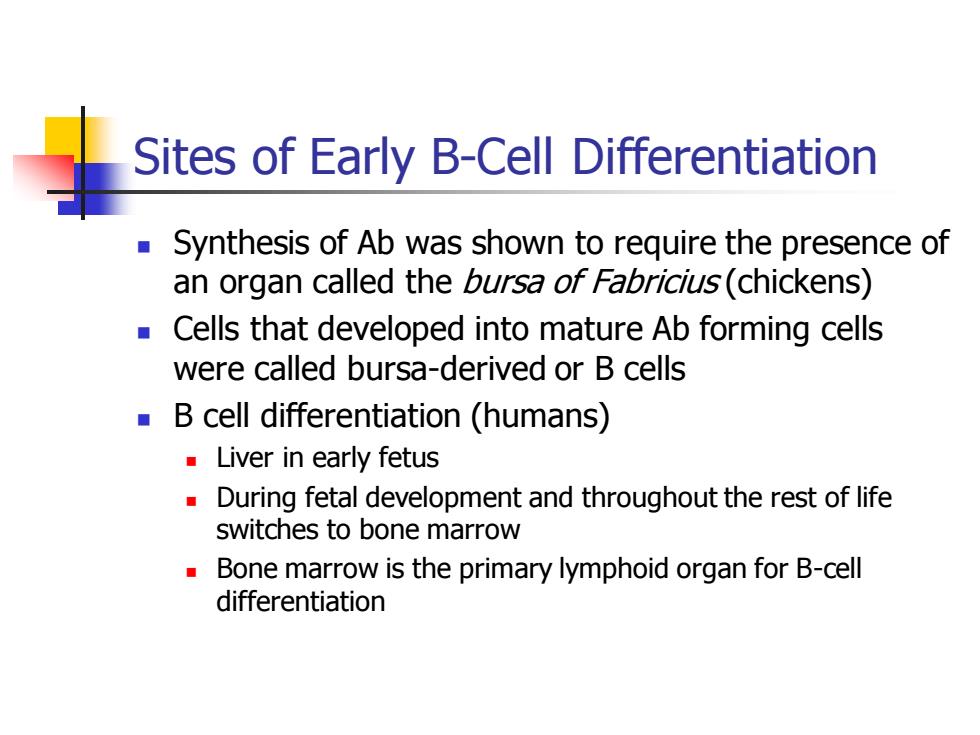
Sites of Early B-Cell Differentiation Synthesis of Ab was shown to require the presence of an organ called the bursa of Fabricius(chickens) Cells that developed into mature Ab forming cells were called bursa-derived or B cells B cell differentiation (humans) Liver in early fetus During fetal development and throughout the rest of life switches to bone marrow Bone marrow is the primary lymphoid organ for B-cell differentiation
Sites of Early B-Cell Differentiation ◼ Synthesis of Ab was shown to require the presence of an organ called the bursa of Fabricius (chickens) ◼ Cells that developed into mature Ab forming cells were called bursa-derived or B cells ◼ B cell differentiation (humans) ◼ Liver in early fetus ◼ During fetal development and throughout the rest of life switches to bone marrow ◼ Bone marrow is the primary lymphoid organ for B-cell differentiation
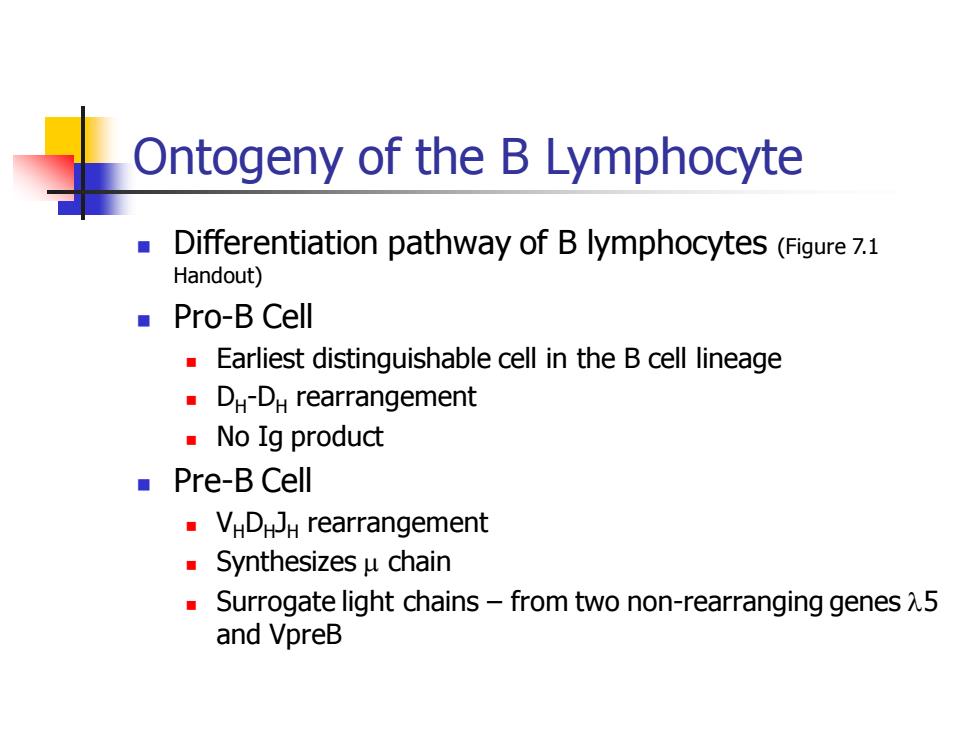
Ontogeny of the B Lymphocyte Differentiation pathway of B lymphocytes(Figure 7.1 Handout) Pro-B Cell Earliest distinguishable cell in the B cell lineage ·DH-DH rearrangement ·No Ig product ■Pre-B Cell ·VHDHJH rearrangement Synthesizes u chain Surrogate light chains-from two non-rearranging genes 5 and VpreB
Ontogeny of the B Lymphocyte ◼ Differentiation pathway of B lymphocytes (Figure 7.1 Handout) ◼ Pro-B Cell ◼ Earliest distinguishable cell in the B cell lineage ◼ DH-DH rearrangement ◼ No Ig product ◼ Pre-B Cell ◼ VHDHJH rearrangement ◼ Synthesizes m chain ◼ Surrogate light chains – from two non-rearranging genes l5 and VpreB
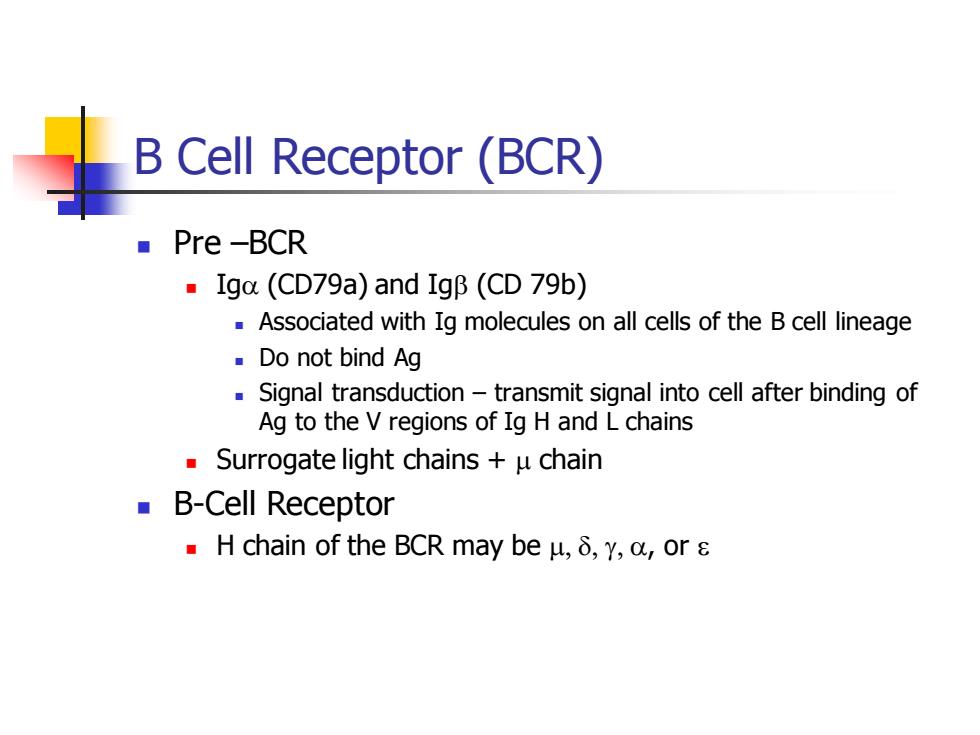
B Cell Receptor (BCR) ■Pre-BCR Iga(CD79a)and IgB(CD 79b) Associated with Ig molecules on all cells of the B cell lineage Do not bind Ag Signal transduction-transmit signal into cell after binding of Ag to the v regions of Ig H and L chains Surrogate light chains +u chain B-Cell Receptor ,H chain of the BCR may be p,δ,Y,,ore
B Cell Receptor (BCR) ◼ Pre –BCR ◼ Iga (CD79a) and Igb (CD 79b) ◼ Associated with Ig molecules on all cells of the B cell lineage ◼ Do not bind Ag ◼ Signal transduction – transmit signal into cell after binding of Ag to the V regions of Ig H and L chains ◼ Surrogate light chains + m chain ◼ B-Cell Receptor ◼ H chain of the BCR may be m, d, g, a, or e
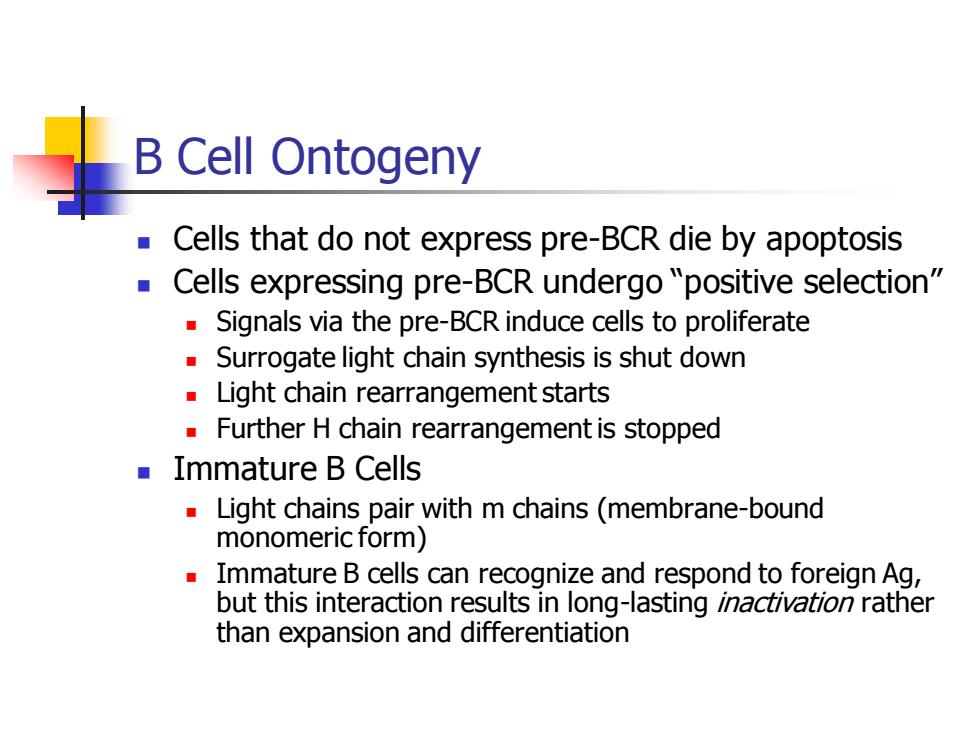
B Cell Ontogeny Cells that do not express pre-BCR die by apoptosis Cells expressing pre-BCR undergo "positive selection" Signals via the pre-BCR induce cells to proliferate Surrogate light chain synthesis is shut down Light chain rearrangement starts Further H chain rearrangement is stopped Immature B Cells Light chains pair with m chains(membrane-bound monomeric form) Immature B cells can recognize and respond to foreign Ag, but this interaction results in long-lasting inactivation rather than expansion and differentiation
B Cell Ontogeny ◼ Cells that do not express pre-BCR die by apoptosis ◼ Cells expressing pre-BCR undergo “positive selection” ◼ Signals via the pre-BCR induce cells to proliferate ◼ Surrogate light chain synthesis is shut down ◼ Light chain rearrangement starts ◼ Further H chain rearrangement is stopped ◼ Immature B Cells ◼ Light chains pair with m chains (membrane-bound monomeric form) ◼ Immature B cells can recognize and respond to foreign Ag, but this interaction results in long-lasting inactivation rather than expansion and differentiation
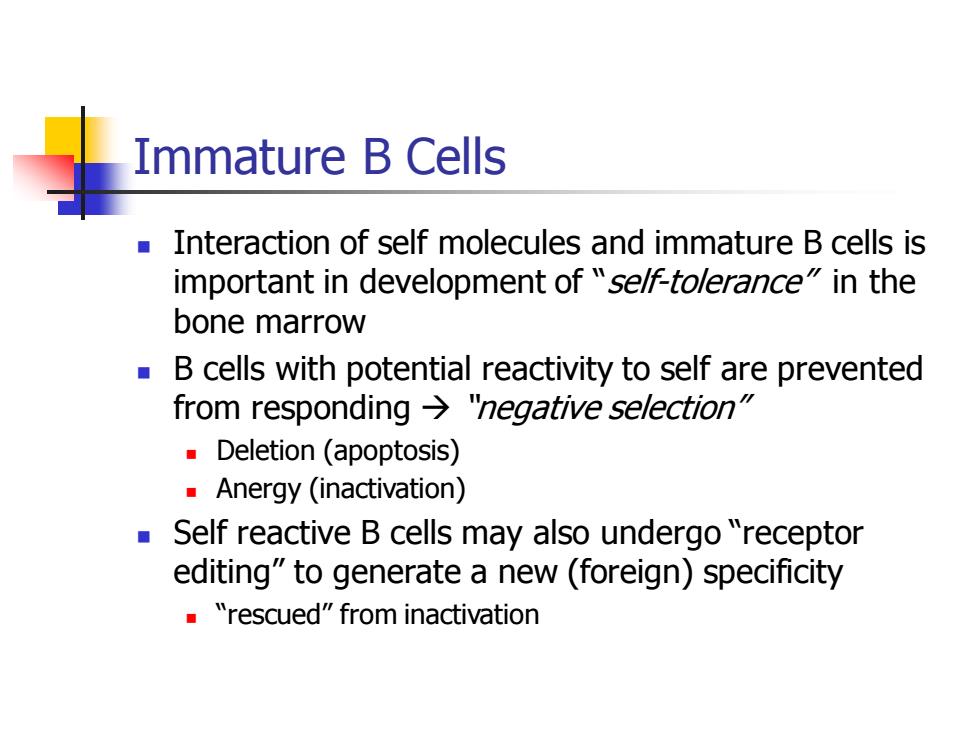
Immature B Cells Interaction of self molecules and immature B cells is important in development of "se/f-tolerance"in the bone marrow B cells with potential reactivity to self are prevented from responding "negative selection" Deletion (apoptosis) Anergy (inactivation) Self reactive B cells may also undergo receptor editing"to generate a new(foreign)specificity "rescued"from inactivation
Immature B Cells ◼ Interaction of self molecules and immature B cells is important in development of “self-tolerance” in the bone marrow ◼ B cells with potential reactivity to self are prevented from responding → “negative selection” ◼ Deletion (apoptosis) ◼ Anergy (inactivation) ◼ Self reactive B cells may also undergo “receptor editing” to generate a new (foreign) specificity ◼ “rescued” from inactivation

Mature B Cells Development of IgM+IgD+mature B cells Predominantly in bone marrow Can also occur in secondary lymphoid organs ■Activation Response to foreign Ag Occurs primarily in secondary lymphoid organs(lymph node and spleen)in the germinal centers Enlarge to become B cell "blasts" Proliferate and differentiate Plasma cells>class switching Memory B cells>class switch but non-proliferating,long-lived
Mature B Cells ◼ Development of IgM+IgD+ mature B cells ◼ Predominantly in bone marrow ◼ Can also occur in secondary lymphoid organs ◼ Activation ◼ Response to foreign Ag ◼ Occurs primarily in secondary lymphoid organs (lymph node and spleen) in the germinal centers ◼ Enlarge to become B cell “blasts” ◼ Proliferate and differentiate ◼ Plasma cells → class switching ◼ Memory B cells → class switch but non-proliferating, long-lived
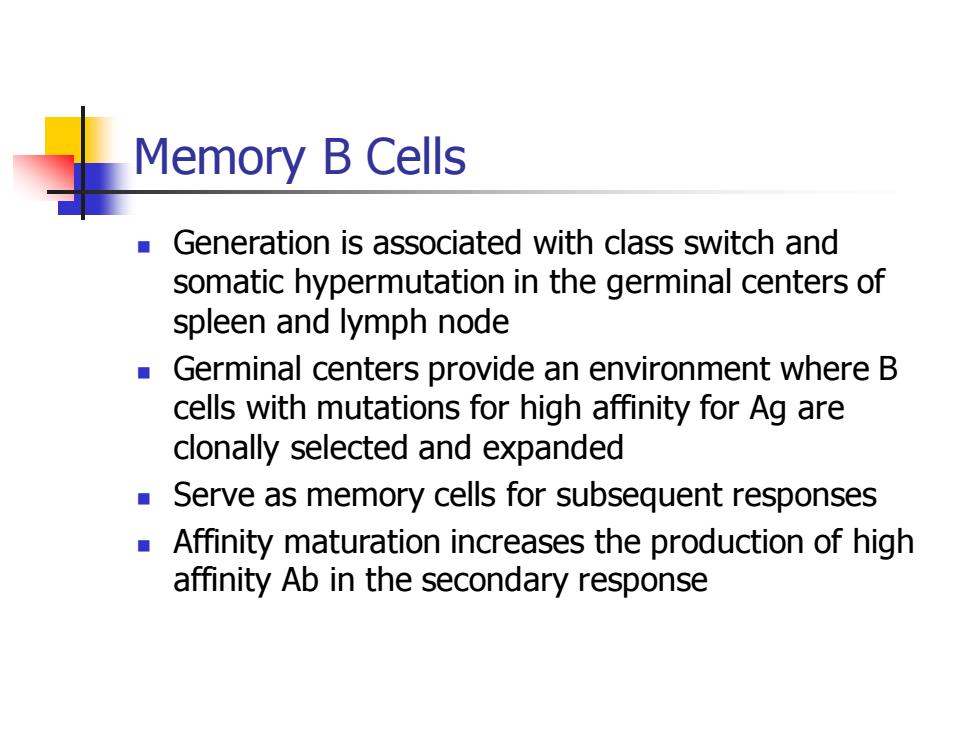
Memory B Cells Generation is associated with class switch and somatic hypermutation in the germinal centers of spleen and lymph node Germinal centers provide an environment where B cells with mutations for high affinity for Ag are clonally selected and expanded Serve as memory cells for subsequent responses Affinity maturation increases the production of high affinity Ab in the secondary response
Memory B Cells ◼ Generation is associated with class switch and somatic hypermutation in the germinal centers of spleen and lymph node ◼ Germinal centers provide an environment where B cells with mutations for high affinity for Ag are clonally selected and expanded ◼ Serve as memory cells for subsequent responses ◼ Affinity maturation increases the production of high affinity Ab in the secondary response

B-1 or CD5+B Cells Most B cells are B-2 type ■B-1 cells Minor population in spleen and lymph nodes Predominate in the peritoneal and pleural cavities ·Express CD5 Synthesize predominantly low affinity IgM in response to bacterial polysaccharide Ags
B-1 or CD5+ B Cells ◼ Most B cells are B-2 type ◼ B-1 cells ◼ Minor population in spleen and lymph nodes ◼ Predominate in the peritoneal and pleural cavities ◼ Express CD5 ◼ Synthesize predominantly low affinity IgM in response to bacterial polysaccharide Ags
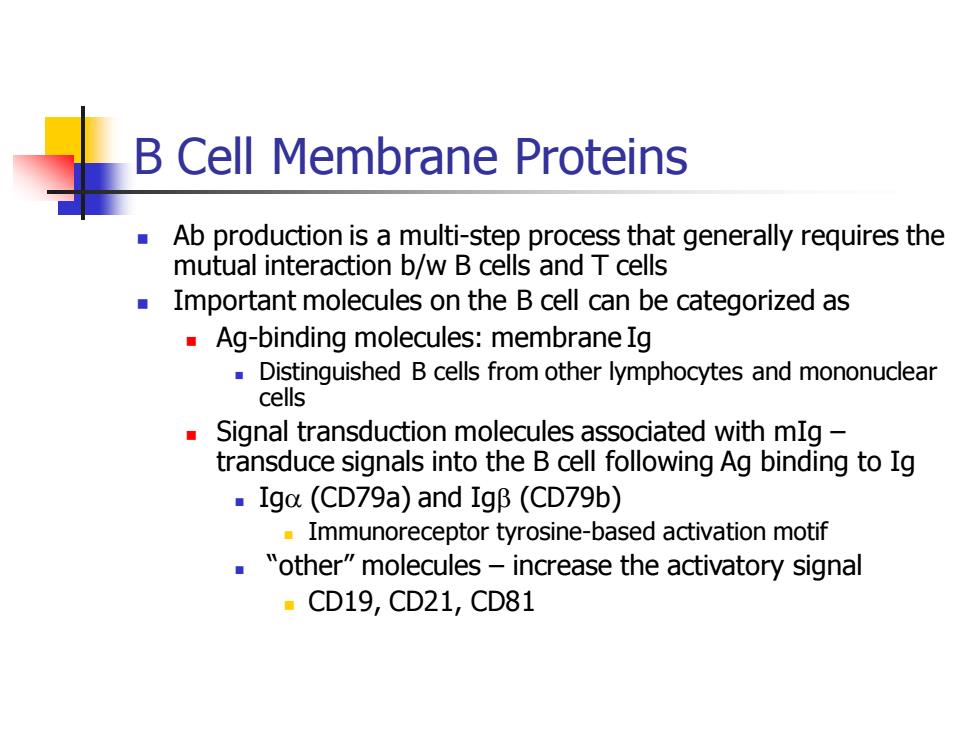
B Cell Membrane Proteins Ab production is a multi-step process that generally requires the mutual interaction b/w B cells and T cells Important molecules on the B cell can be categorized as Ag-binding molecules:membrane Ig Distinguished B cells from other lymphocytes and mononuclear cells Signal transduction molecules associated with mIg- transduce signals into the B cell following Ag binding to Ig Iga(CD79a)and IgB(CD79b) Immunoreceptor tyrosine-based activation motif "other"molecules-increase the activatory signal ·CD19,CD21,CD81
B Cell Membrane Proteins ◼ Ab production is a multi-step process that generally requires the mutual interaction b/w B cells and T cells ◼ Important molecules on the B cell can be categorized as ◼ Ag-binding molecules: membrane Ig ◼ Distinguished B cells from other lymphocytes and mononuclear cells ◼ Signal transduction molecules associated with mIg – transduce signals into the B cell following Ag binding to Ig ◼ Iga (CD79a) and Igb (CD79b) ◼ Immunoreceptor tyrosine-based activation motif ◼ “other” molecules – increase the activatory signal ◼ CD19, CD21, CD81